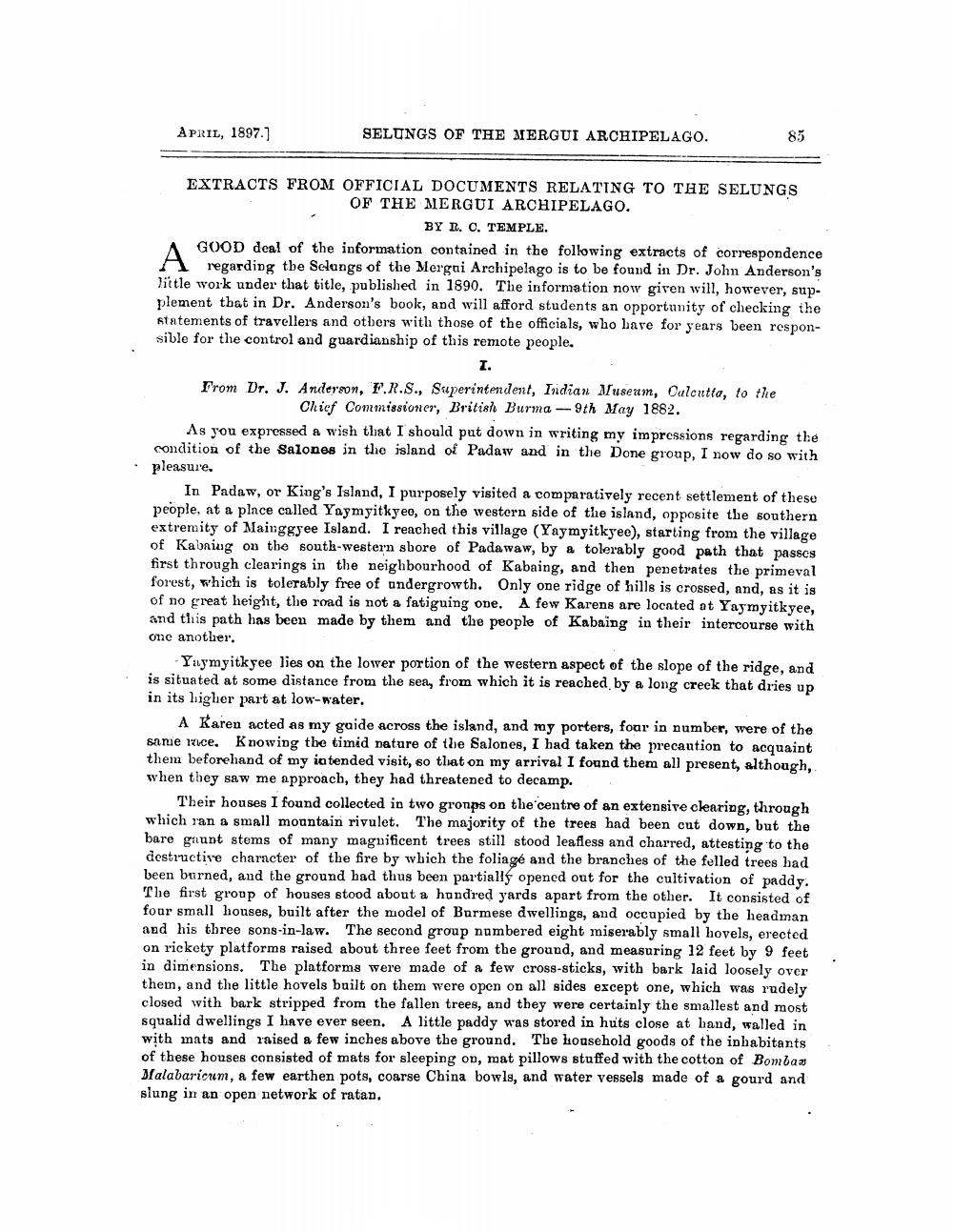________________
APRIL, 1897.]
SELUNGS OF THE MERGUI ARCHIPELAGO.
85
EXTRACTS FROM OFFICIAL DOCUMENTS RELATING TO THE SELUNGS
OF THE MERGUI ARCHIPELAGO.
BY R. C. TEMPLE. GOOD deal of the information contained in the following extracts of correspondence A regarding the Scungs of the Mergai Archipelago is to be found in Dr. John Anderson's little work under that title, published in 1890. The information now given will, however, supplement that in Dr. Anderson's book, and will afford students an opportunity of checking the statements of travellers and others with those of the officials, who have for years been responsible for the control and guardianship of this remote people,
From Dr. J. Anderson, F.R.S., Superintendent, Indian Museum, Calcutta, to the
Chic Commissioner, British Burma - 9th May 1882. As you expressed a wish that I should put down in writing my impressions regarding the condition of the Salones in the island of Padaw and in the Done group, I now do so with pleasure.
In Padaw, or King's Island, I purposely visited a comparatively recent settlement of these people, at a place called Yaymyitkyeo, on the western side of the island, opposite the southern extremity of Mainggyee Island. I reached this village (Yaymyitkyee), starting from the village of Kabning on the south-western sbore of Padawaw, by a tolerably good path that passes first through clearings in the neighbourhood of Kabaing, and then penetrates the primeval forest, which is tolerably free of undergrowth. Only one ridge of hills is crossed, and, as it is of no great height, the road is not a fatiguing one. A few Karens are locnted at Yaymyitkyee, and this path has been made by them and the people of Kabaing in their intercourse with one another.
Yuvymyitkyee lies on the lower portion of the western aspect of the slope of the ridge, and is situated at some distance from the sea, from which it is reached by a long creek that dries up in its liigler part at low-water.
A Karen acted as my gaide across the island, and my porters, foar in number, were of the same wce. Knowing the timid nature of the Salones, I had taken the precaution to acquaint them beforehand of my intended visit, so that on my arrival I found them all present, although, when they saw me approach, they had threatened to decamp.
Their houses I found collected in two gronps on the centre of an extensive clearing, through which ran a small mountain rivulet. The majority of the trees had been cut down, but the bare gaunt stems of many magnificent trees still stood leafless and charred, attesting to the destructive character of the fire by which the foliage and the branches of the felled trees bad been burned, and the ground bad thus been partially opened out for the cultivation of paddy. The first group of houses stood about a hundred yards apart from the other. It consisted of four small houses, built after the model of Burmese dwellings, and occupied by the headman and his three sons-in-law. The second group numbered eight miserably small hovels, erected on rickety platforms raised about three feet from the ground, and measuring 12 feet by 9 feet in dimensions. The platforms were made of a few cross-sticks, with bark laid loosely over them, and the little hovels built on them were open on all sides except one, which was rudely closed with bark stripped from the fallen trees, and they were certainly the smallest and most squalid dwellings I have ever seen. A little paddy was stored in huts close at hand, walled in with mats and raised a few inches above the ground. The household goods of the inhabitants of these houses consisted of mats for sleeping on, mat pillows stuffed with the cotton of Bombas Malabaricum, a few earthen pots, coarse China bowls, and water vessels made of a gourd and slung in an open network of ratan.




